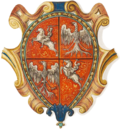| Lis | |
|---|---|
 | |
| Battle cry | Lis, Orzy Orzy, Strzępacz |
| Alternative name(s) | Bzura, Sikora, Strępaca, Lisy, Murza, Vulpis |
| Earliest mention | 1306 (seal) |
| Families | 265 names Abrek, Bachcicki, Bartłomiejewicz, Bechcicki, Bechczycki, Beglewski, Beglowski, Benet, Bianki, Biegłowski, Biskupski, Blazevicius, Bolesraszycki, Bolestraszycki, Borowski, Bucela, Bucell, Buchczycki, Bukcicki, Bukczycki, Bzura, Bzurski, Chomętowski (Chomutowski, Chomątowski), Chomiński, Chrapkowski, Chrzelowski, Cieszowski, Czarnecki, Czarnocki, Czarnowski, Czyż, Czyżogórski, Długokęcki, Doraszkiewicz, Doroszek, Doroszkiewicz, Doroszko, Doroszkowski, Drobisz, Elzbut, Filipowicz, Foland, Fulko, Fułko, Gatardowicz, Gawecki, Gawęcki, Gawianowski, Gertut, Giebułtowski, Gielbutowski, Gieniusz, Glikowski, Gliński, Gniewecki, Gniewięcki, Gołuchowski, Gomuński, Gordziejowicz, Gotardowicz, Gotartowski, Gottart, Goworski, Grajbner, Grodowski, Grudowski, Grzegorzewski, Grzywa, Holenczyński, Homentowski Pieczynoga, Hukowski, Irząd, Iwasieńcowicz, Iwaszeńcewicz, Iwaszeńcowicz, Jarnicki, Jerlicz, Jęczyński, Jodko, Jonczyński, Jurjewicz, Kanigłowski, Kanigowski, Kantur, Karnysz, Kasicki, Kęsztort, Kieysztor, Kirkiłło, Klimuntowski, Kniehenicki, Kolesiński, Komoński, Komuński, Konstantynowicz, Kontrym, Kończa, Kosman, Kosmowski, Kostrzewski, Kozakowski, Kozłowski, Koźniński, Kroiński, Kuszczycki, Kutyłowski, Kwetko, Kwileński, Kwiliński, Latecki, Letecki, Lipicki, Lis, Lisański, Lisiak, Lisiański, Lisicki, Lisiecki, Lisowiecki, Lisowski, Lissowski, Łącki, Macowicz, Majkut, Makarewicz, Makarowicz, Malużeński, Malużyński, Małuszeński, Małużeński, Marchel, Medeksza, Metra, Michajłowicz, Michałowicz, Michałowski, Michayłowicz, Michniewicz, Miechorzewski, Miechorzowski, Mieszkowski, Mikołajczewski, Mikołajewski, Mikołajski, Mikorski, Mikuczewski, Miroński, Mnichowski, Moneta, Mytko, Nacewicz, Nacowicz, Naczowicz, Narbut, Narkiewicz, Niecikowski, Nieczycki, Niestojkowicz, Nieszycki, Nietecki, Nieznanowski, Nowkuński, Ochab, Ochap, Olszewski, Ołtarzewski, Omeluta, Osendowski, Osędowski, Ossendowski, Paśmieski, Petraszkowicz, Petrowicz, Piaseczyński, Piasocki, Pieczenga, Pieczęga, Pieczonka, Pieczynga, Pietkiewicz, Pohowicz, Pohozy, Postrumieński, Princewicz, Proszczowicz, Przędziński, Radzimiński, Radzymiński, Rappold, Reynhard, Roszczyc, Roszczyna, Rosznicki, Rościsz, Roźnicki, Rożnicki, Rożniecki, Rudnicki, Ruszczeński, Ruszczyc, Ruszczyński, Ruszel, Ruściński, Rymwid, Samsonowicz, Sangayło, Sapieha, Saułukowicz, Sikora, Sikorski, Sipowicz, Słowik, Słupski, Sokora, Spirydynow, Spirydynowicz, Spiżarny, Stanisławowicz, Starzeński, Starzyński, Strażyński, Strzeblewski, Strzelbowski, Sudyk, Sumigajło, Sungayło, Szkudliski, Szweger, Śmieciński, Światopełk, Światopełkowicz, Świrski, Tałatowicz, Tausz, Tausza, Trzonoski, Tymiński, Uchorowski, Uliński, Wankowicz, Wańkowicz, Wańkowski, Wasiencowicz, Werbski, Wereszczaka, Wichorowski, Wiereszczaka, Wierzbski, Wieźliński, Wieżliński, Wilkanowski, Wojtechowicz, Wolan, Wolski, Wołotkowicz, Woronowicz, Worowski, Wroniewski, Wróblewski, Wysocki, Zabeło, Zabiełło, Zadambrowski, Zadąbrowski, Zając, Zaleski, Zawadzki, Zbiełło, Zbieło, Zdan, Żarno Contents |
| Cities | Jędrzejów, Rydzyna |
Lis (Polish for "Fox") is a Polish coat of arms. It was used by many noble families of Clan Lis.





